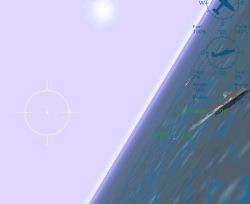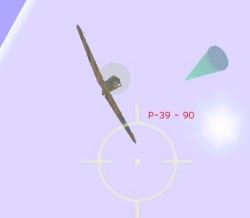| Pacific Theatre for CFS
by Leonard "Viking1" Hjalmarson |
||||
|
What is currently the single most demanded setting for a World War II simulation? You guessed it: the Pacific Theatre. Abacus has enabled Combat Flight Simulator fans to relive Pearl Harbor, flying on the American or the Japanese sides in that deadly surprise attack. You won't rewrite history, but you can get into the melee. Comes In a Box Pacific Theatre includes a fifty+ page manual that holds both installation and historical information. A short history of the Pacific Theatre sets the stage, followed by a number of CV's... try Major Richard I. Bong and Sergeant Satoru Anabuki for starters, top Aces of the Pacific. Pacific Theatre allows you to fly in or against twelve classic WWII fighter aircraft. The aircraft are described in detail in the manual and are these: USAAF:
Japanese:
The manual gives a brief history of the Pacific theatre, focussing on Pearl Harbor. What makes this scenario so attractive to simulate is this: "WWII's Pacific Theatre marked a change from battles fought with guns to battles fought with aircraft. Aircraft filled a support role in Europe, but they became the primary weapon and reconnaissance tool in the Pacific. "When the US joined the war, the Imperial Japanese Navy boasted the best-trained and best equipped naval air force in the world. The premiere Japanese naval fighter, the Mitsubishi Zero, could outmanouver any landbased or carrier-based aircraft. Also, the skills of the pilots impressed everyone they met who lived to tell a tale." Installation and Configuration Test System:
Installation was a snap. The only condition is selecting your default CFS directory. I loaded up CFS and configured it for 1024x768. CFS is Direct3d only, a bit of a handicap for a Banshee board which was later reflected in challenging frame rates. I set full realism including HARD flight model and limited gas and ammo. I set enemy AI on the middle Veteran level. |
 Pearl Harbor from the air. The Attackers I dove into the first mission, flying an A6M2 Zero for the Japanese. The Zero was indeed a fantastic aircraft, but in this first flight I began noticing some of the limitations of the Pacific Theatre package. Before I tell you what I didn't like, however, let me tell you the good stuff. I took off from the Carrier and then circled for a look around at the Fleet. Quite nicely done. The "feeling" of flight is good. Once my wingmen were in the air I hit X to arrive a Pearl Harbor.
 The Japanese Fleet There is tons of action and a lot of radio chatter. Within the first minute my comrades are making hits on ships, and there is flak in the air and smoke rising from the crippled ships. A few Kates are being shot down or hit by flak, but the impression is visceral. I feel odd flying in a Japanese crate instead of defending the Pacific Fleet! There are far too many USAAF aircraft in the air, this is history with a twist. Obviously, the mission wouldn't be much of a challenge without a good number of airborne opponents.
 On the tail of a P40-B
 Pearl off the left wing. I am thinking, "I like this." But there are some things beginning to nag at me. First, it's too easy to yank and bank. This Zeke doesn't seem to bleed speed at all. Second, why does the engine sound not change when I reduce throttle? I asked Abacus' Jim Rhoades about this and he replied: "It may be the fact that some of the airfiles pertaining to the planes with tail hooks for carrier landings are FS98 optimized air files. CFS airfiles do not seem to handle tail hooks (spoilers) very well so a few FS98 air files were used and optimized for these models. Consequently, FS98 air files especially prop planes, do not bleed speed very quickly and the sounds you may be hearing could be a result of that factor." Go to Page Two
|
|||
|
Copyright © 1997 - 2000 COMBATSIM.COM, INC. All Rights Reserved. Last Updated June 21st, 1999 |
||||
